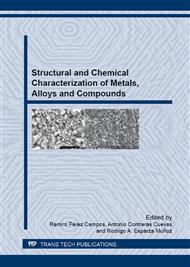[1]
W. Chen, J. S. Wu, J. H. Yuan, X. H. Xia and X. H, An environment-friendly electrochemical detachment method for porous anodic alumina, J. Elec. Chem. 600 (2007) 257-264.
DOI: 10.1016/j.jelechem.2006.10.022
Google Scholar
[2]
S. Shingubara, Fabrication of Nanomaterials Using Porous Alumina Templates, J. Nanopart. Res. 5 (2003) 17-30.
Google Scholar
[3]
C. Y. Suh and J. Sang, Electrochemical fabrication of CdS/Co nanowire arrays in porous aluminum oxide templates, Bull. Korean Chem. Soc. 23 (2002) 1519-1523.
DOI: 10.5012/bkcs.2002.23.11.1519
Google Scholar
[4]
G. Che, B. B. Lakshmi, E. R. Fisher and C. R. Martin, Carbon nanotubule membranes for electrochemical energy storage and production, Nature 393 (1998) 346-349.
DOI: 10.1038/30694
Google Scholar
[5]
K. Fukuda and H. Masuda, Ordered metal nanohole arrays made by a two-step replication of honeycomb structures of anodic alumina, Science 268 (1995) 1466-1468.
DOI: 10.1126/science.268.5216.1466
Google Scholar
[6]
L. Ba and W. S. Li, Influence of anodizing conditions on the ordered pore formation in anodic alumina, J. Phys. D: Appl. Phys. 33 (2000) 2527-2531.
DOI: 10.1088/0022-3727/33/20/302
Google Scholar
[7]
V.I. Shershulsky and V. P. Parkhutik, Theoretical modelling of porous oxide growth on aluminium, J. Phys. D: Appl. Phys. 25 (1992) 1258-1263.
DOI: 10.1088/0022-3727/25/8/017
Google Scholar
[8]
G. E. Thompson, Porous anodic alumina: fabrication, characterization and applications, Thin Solid Films 297 (1997) 192-201.
DOI: 10.1016/s0040-6090(96)09440-0
Google Scholar
[9]
E. V. Koroleva, G. E. Thompson, P. Skeldon and B. Noble, Crystallographic dissolution of high purity aluminium, Proc. Royal Soc. A. 463 (2007) 1729-1748.
DOI: 10.1098/rspa.2007.1846
Google Scholar
[10]
J. J. Perez Bueno, M. E. Rodriguez, O. Zelaya-Angel, R. Baquero, J. Gonzalez-Hernadez, L. Baños and B. J. Fitzpatrick, Growth and characterization of Cd1−xZnxTe crystals with high Zn concentrations, J. Crystal Growth 209 (2000) 701-708.
DOI: 10.1016/s0022-0248(99)00514-x
Google Scholar
[11]
G. Bailey and G. C. Wood, The morphology of anodic films formed on. aluminium in oxalic acid, Trans. Inst. Metal. Finish. 52 (1974) 187-199.
DOI: 10.1080/00202967.1974.11870328
Google Scholar
[12]
G. Patermarakis, Aluminium anodising in low acidity sulphate baths: growth mechanism and nanostructure of porous anodic films, J. Solid State Electrochem. 10 (2006) 211-222.
DOI: 10.1007/s10008-005-0665-7
Google Scholar
[13]
J.M. Mortero, M. Sarret and C. Müller, Self-ordered porous alumina by two-step anodizing at constant current: Behaviour and evolution of the structure, Micropor. Mesopor. Mat. 136 (2010) 68-74.
DOI: 10.1016/j.micromeso.2010.07.022
Google Scholar
[14]
G. Patermaraki, J. Chandrinos and K. Masavetas, Formulation of a holistic model for the kinetics of steady state growth of porous anodic alumina films, J. Solid State Electrochem. 11 (2007) 1191-1204.
DOI: 10.1007/s10008-006-0259-z
Google Scholar
[15]
S. H. Ko, D. W. Lee, H. C. Park, K. H. Lee and W. Hwang, Mechanical properties and residual stress measurements in anodic aluminium oxide structures using nanoindentation, Glass Phys. Chem. 31 (2005) 356-363.
DOI: 10.1007/s10720-005-0069-x
Google Scholar
[16]
K. Nielsch, J. Choi, K. Schwirn, R. B. Wehrspohn and U. Gosele, Self-ordering regimes of porous alumina: The 10 porosity rule, Nanoletters 2 (2002) 677-680.
DOI: 10.1021/nl025537k
Google Scholar


